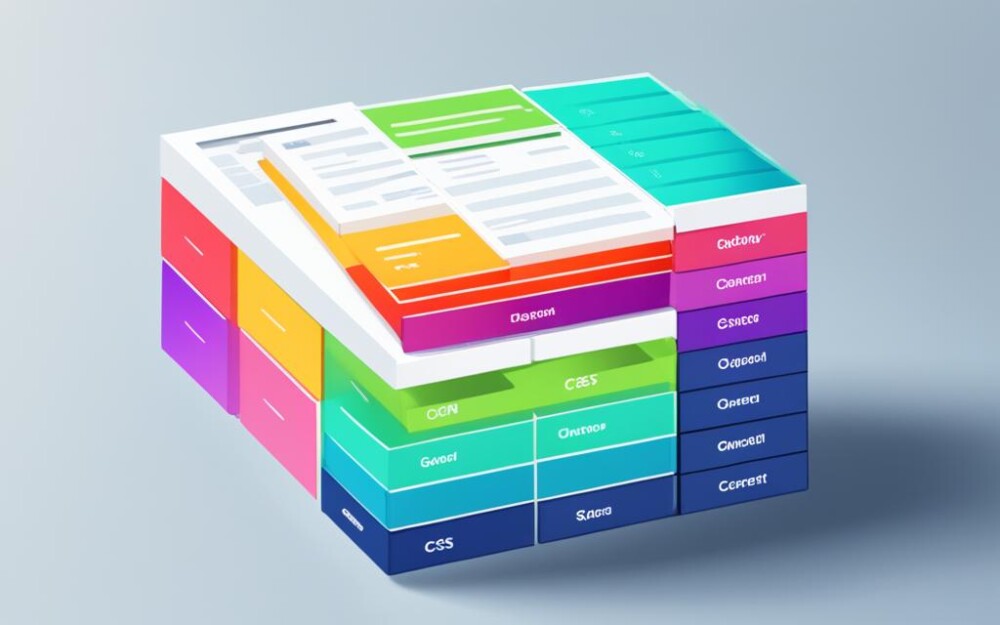Web development is always changing. To keep up, it’s crucial. With new technology and higher user demands, developers need to make sure websites look great on any device. For a long time, CSS media queries helped with this. But their limits are clear now. This led to a new way of thinking: CSS container queries.1 This new tool lets developers style elements based on where they are on the page, not just the screen size.1 It’s a big shift that lets us make components that really fit their space. No more one-size-fits-all. Now, every piece on a website can adjust perfectly to its area.
Understanding CSS Container Queries
CSS container queries change how we design websites. They allow changing styles based on the container size and context, not just the screen size. This makes designs adapt better to different devices.2 It lets developers make elements that adjust well, no matter the screen they’re on.3
Introducing Container Queries
CSS media queries help designs fit all screens, but they’re not perfect. They only look at the screen size, not the size of elements inside the layout.3 This is a problem when things inside a layout change size. It can lead to using tricky JavaScript or complex CSS to fix the design.
On the other hand, container queries are like a better version. They focus on how elements change inside their containers, making things more adaptable. This way, designs can be truly responsive, easily adjusting to what’s needed.
Addressing the Limitations of Traditional Responsive Design
Container queries step in to solve the design puzzle. They work with CSS grid and flexbox to make designs act smartly based on their containers.3 While grid and flexbox deal with horizontal and vertical layouts really well, they lack in flexible adjustments. Container queries fill this gap nicely, offering a full solution for adaptability.
Paving the Way for Container Queries
With container queries, developers can do more with designs. They can fine-tune styles based on each element’s container, not just the overall screen. This leads to smarter designs that look good no matter the device.
The Role of Container Queries in Component Styling
Container queries let developers style components based on their container’s traits. They bring about a fresh approach to designing components.4 By setting specific rules with the `@container` rule, developers can make layouts that adjust smartly to changes in container size. This ensures designs look good on all devices.
Defining Container Queries
Container queries use a syntax similar to media queries but with container dimensions. This setup helps developers use their CSS skills for responsive layouts.4 The process is made smoother with this familiar style.
Applying Conditional Styles with Container Queries
Let’s say we use `inline-size` for the `container-type`. Then, the `@container` rule sets when styles change, like when the container is 750 pixels wide or less.5 In this case, if the container is small, a `.card` element switches to a `column` layout.
Practical Magic: A Container Query Case Study
Container queries help make components that ‘learn’ from their surroundings, becoming truly adaptive. This means a better experience for users and consistent design quality on all screens.45
CSS Container Queries
CSS container queries change how we make websites fit all screens. This method lets developers style elements to fit their container size and context, not just the screen size. It makes sure everything looks good, no matter the screen.
Its special power? It can handle changing content and layouts. Unlike old ways that consider only the screen size, this focuses on each element’s size. When an element grows or shrinks, its style changes to stay perfect, making the design always look good.
Container queries work with different kinds of elements like inline-size and grid. This helps make components that fit exactly in their space, not wasting any room. It’s way smarter than old methods that only look at the screen size.
Thanks to container queries, we now have special CSS units like cqw and cqh. These let us set components’ size based on the container. It’s a big step in making designs that truly adapt to any space they’re given.6
More and more people are using container queries. But for now, some browsers may not support them. In those cases, there are tricks like backup plans. These ensure the site works well for everyone, no matter their browser.
By getting into container queries, web designers can do amazing things. They can make sites that truly fit their users’ needs. It’s an exciting time, and these new methods are changing how we design the web.
Advanced Concepts in Container Queries
The world of CSS container queries is always changing. Now, developers have more tools to make responsive designs better. They should learn about container units (CQ units) and browser support and fallback strategies.
Container Units (CQ Units)
Container queries bring new CSS units to work with. These include cqw for width and cqh for height. They let developers size elements based on the container, not just the screen size.2 This makes designs more detailed and adaptable.
Browser Support and Fallback Strategies
Modern browsers are catching up with container query support,3 like Chromium and Edge (105+) and Safari (16+). But with older browsers, we need fallbacks. This ensures everyone sees a design that works for them. Techniques like @supports help with this.2 Doing this keeps your project ready for the future of web design.
Learning these advanced features in container queries is key. It lets developers create websites that adjust well to any device. This way, users will enjoy the experience, no matter what they’re using.
Conclusion
Technology is growing, and people expect more from the web. This means we need web designs that adapt, respond, and look great. CSS container queries are changing the game in web development. They give us a better way to make web designs that fit all devices, breaking free from old limits.2
With this new approach, developers can make things that know how to look good everywhere. This means a better and more united experience for users, no matter the device or screen size.7
As more people use container queries, the developers who understand them will have an edge. They can make modern web apps that last. So, dive into CSS container queries, and start changing how we do web design in a better way.27

